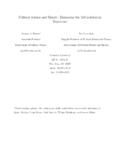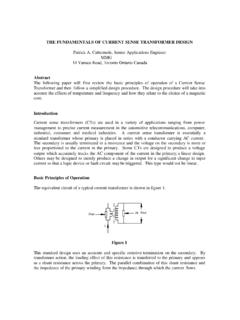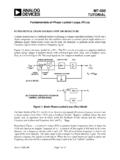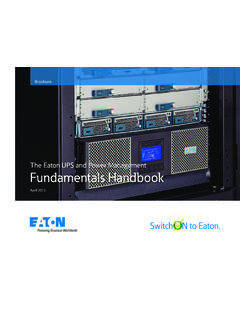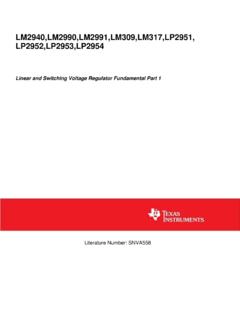Transcription of Interest Rate Fundamentals - Columbia University
1 Lecture 1 Part II. Interest Rate Fundamentals Topics in Quantitative Finance: Inflation Derivatives Instructor: Iraj Kani Fundamentals of Interest rates In part II of this lecture we will consider fundamental concepts of Interest rates , including risk-free rate and money market account, zero coupon bonds, spot and forward Interest rates , day-count and compound conventions, and general Interest rate curves. We will also review standard market conventions for bond and swap pricing, as well as pricing of Interest rate caps, swaptions and bond options.
2 The Money Market Account and the Short Rate The first definition we will consider is the (continuously compounded) bank account, or money market account. A money-market account represents a (locally) risk-less investment, with profits accruing continuously at the risk-free rate prevailing in the market at any instant. Money Market Account: We define B(t) to be the value of (continuously compounded) bank account at time t 0 . We assume that B(0) = 1 and that the bank account evolves according to the following differential equation: dB (t ) = rt B (t )dt , B (0) = 1 (EQ 1).
3 Where rt is a positive (possibly stochastic) real-valued process. As a consequence B (t ) = exp rs ds . t (EQ 2). 0 . The above definition tell us that investing a unit of currency at time 0 yields at time t the value in Equation 2, and rt is the instantaneous rate at which the bank account accrues. This instantaneous rate is usually referred to as instantaneous spot rate or, more simply, the short rate. In fact, in an arbitrary small time interval [t , t + t ) we have: B (t + t ) B (t ). = r (t ) t (EQ 3). B (t ). Hence, the bank account grows at a rate r(t).]
4 It follows that the value at time t of a unit of currency payable at time T is given by B (t ) / B (T ) . This leads to the following definition: Stochastic Discount Factor: The (stochastic) discount factor D(t,T) between two times t and T is the amount at time t that is equivalent to one unit of currency payable at time T, and is given by: B (t ). = exp rs ds . T. D (t , T ) = (EQ 4). B (T ) t . When applying the Black-Scholes to equity or foreign-exchange (FX) markets, r is assumed to be deterministic function of time, so that the bank account and the discount factors at any future time are deterministic functions of time.
5 However, when dealing with Interest -rate products, the probabilistic nature of rt is important since it affects the nature of the bank-account numeraire B, and hence the pricing of Interest -rate products. It is therefore necessary in those contexts to drop the deterministic setup and to start modeling the evolution of r in time through a stochastic process. Zero-Coupon Bonds and Spot Interest rates Zero-Coupon Bond: A T-maturity zero-coupon bond (pure discount bond) is a contract that guarantees its holder the payment of one unit of currency at time T with no intermediate payments.
6 The contract value at time t < T is denoted by P(t,T). Clearly P(T,T) = 1 for all T. If the current time is t, a zero-coupon bond for maturity T is a contract that establishes the present value of one unit of currency to be paid at time T, the maturity of the contract. If rates rt are deterministic, then D is deterministic as well and necessarily D(t,T) = P(t,T). for all (t,T). However, if rates are stochastic, D(t,T) is a random quantity at time t depending on the future evolution of r between t and T. Since the zero-coupon bond price, being the time t- value of a contract with payoff at time T, P(t,T), has to be known (deterministic) at time t.
7 We will see that P(t,T) can be viewed as expectation of the random variable D(t,T) under a particular probability measure (risk-neutral measure). Time to Maturity: The time to maturity T t is the amount of time (in years) from the present time t to the maturity T > t. The definition makes clear and definite sense when t and T are real numbers associated with two instances of time. However, if t and T denote two dates expressed as day/month/year, say D1 = (d1 , m1 , y1 ) and D2 = (d 2 , m2 , y 2 ) , we need to define the amount of time between the two dates of number of days (or years) between them.
8 This choice, however, is not unique, and the market evaluates the time between t and T in different ways. Indeed, the number of days between D1 and D2 is calculated according to the relevant market convention, which tells us how to count days (day count convention), whether to include holidays (holiday conventions) and so on. Day-count Convention / Year Fraction: We denote by (t , T ) the chosen time measure between t and T, which is usually referred as the year fraction between t and T. When t and T are less than one day, (t , T ) is to be interpreted as T t (in years).
9 Otherwise we require a choice of day-count convention. Here are some examples of day- count conventions: Actual / 365 Convention (ACT/365): With this convention the year is 365 days long, and the year fraction between two dates is the actual number of days between them divided by 365. If we denote by D2 D1 the actual number of days between the two dates above, we have the year fraction in this case as D2 D1. 365. For example, the year fraction between January 4, 2000 and July 4, 2000 is 182 / 365. = Actual / 360 Convention (ACT/360): A year in this case is assumed to be exactly 360 days long.
10 The corresponding fraction is D2 D1. 360. Therefore the year fraction between January 4, 2000 and July 4, 2000 is 182 / 360 =. 050556. 30 / 360 Convention: With this convention, months are assumed to be exactly 30. days long and years are assumed 360 days long. The year fraction in this case between the dates is defined by: max(30 d 1 ,0) + min(d 2 ,30) + 360 * ( y 2 y1 ) + 30 * (m 2 m1 1). 360. For example, the year fraction between January 4, 2000 and July 4, 2000 is now: (30 4) + 4 + 360 * 0 + 30 * 5. = 0 .5. 360. Actual / Actual Convention (ACT/ACT): In this case the year fraction between two dates is the actual number of days between them divided by number of days in a year beginning on a reference date, normally chosen to be equal to the earlier of the two dates.









